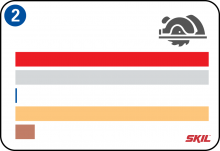-
Which saw to use for each job?
-
= Speed
= Accuracy
= Sawing curves
= Sawing straight
= Sawing in hard-to-reach areas
-
1) Jigsaw
A jigsaw is the most versatile kind of saw. It can accurately cut both straight lines and curves. Especially for sawing curves, a jigsaw is clearly the best option. A jigsaw can use a wide variety of blades, optimized for different materials, accuracy, speed and curves. Examples of materials that can be cut are wood, metal, plastic, drywall, laminated boards and even ceramic tiles. -
2) Circular saw
A circular saw is mostly used for fast, accurate cutting of straight lines. It excels in making long cuts in thicker materials. Circular saws are mainly used for wood, although they can also cut other materials – in some cases using a special saw blade. Some of the most common materials that can be cut using a circular saw are chipboard, plywood, wooden beams, hardwood flooring and underlayment panels. -
3) Reciprocating saw
A recip saw – short for reciprocating saw or sabre saw – is mainly used for rough cutting, pruning and demolition work. Different blades are available for specific materials such as wood and metal. -
4) Multisaw
A multisaw is ideal for cutting a wide range of materials: you only need one tool to cut many different materials. From wood to tiles, laminate flooring to aluminum and PVC. It saws straight lines accurately, and is also very handy for plunge cutting. A multisaw can be used with kinds of saw blades, for example diamond disks, HSS blades and Carbide Tipped blades. These blades are all available in most DIY shops.




